By Alibaba Cloud Storage Team
At The Computing Conference 2018 in Hangzhou, Alibaba Cloud presented its Hybrid Disaster Recovery (HDR) and Hybrid Backup Recovery (HBR) solution by demonstrating a full disaster recovery process on stage. The five-minute HDR demonstration presented the end-to-end process of enterprise application disaster recovery with Alibaba Cloud's second-level recovery point objective (RPO) and minute-level recovery time objective (RTO), covering the core steps of a typical cloud disaster recovery scenario.
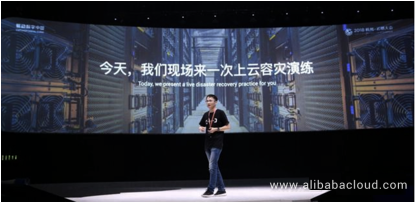
We all know that downtime of key business brings great losses to enterprises. Traditional self-built disaster recovery solutions are costly and require complex operation and maintenance (O&M), so high-performance cloud disaster recovery services are becoming the preferential choice for enterprises to ensure business continuity. The HDR solution for key business fully demonstrates the real-time disaster recovery replication of an accounting system running on a local server to Alibaba Cloud, and quickly recovers the business on Alibaba Cloud after the downtime.

The entire demonstration was divided into three phases:
In the digital economy era, data is growing exponentially. In just a few years, the amount of data has jumped from the TB level to the PB or even ZB level.
According to surveys conducted by research institutions, the total amount of data exceeded 15.2 ZB in 2017, with a year-on-year increase of 35.7%. The total amount of global data will reach 19.4 ZB by 2018. In the next few years, the global data will grow at a rate of more than 25% per year. The global data amount is expected to hit 50 ZB by 2020.
Undeniably, data is the core of digital operations and data security determines the survival of enterprises.
In August 2018, an international cloud service provider reported data leakage because its sales staff did not follow the specifications for a bucket.
In July 2018, a serious failure was exposed on a Chinese cloud platform. The failure directly led to the loss of all data of a startup company, which then faced an unprecedented shutdown crisis.
On May 12, 2017, the WannaCry worm incident caused chaos across the world. ATMs in banks were out of order, computers in gas stations broke down, and students' theses were encrypted.
In January 2017, the O&M personnel of a code hosting platform mistook the production environment for a test environment during multi-terminal switching and accidentally deleted the database of the production environment.
In November 2014, a financial payment company experienced a system failure, causing nearly 400 million duplicated receipts.
According to IDC statistics, 55% of the companies that experienced disasters in the past decade collapsed right away. In the remaining 45%, 29% also went bankrupt within two years due to data loss. Only 16% survived.
According to a Gartner report, two-fifths of the companies that experienced system downtime due to major disasters never resumed operations again, and one-third of the remaining companies went bankrupt within two years.
In this context, enterprises urgently need to strengthen data protection.
The hybrid cloud backup and disaster recovery solution is the first choice for enterprises' digital transformation. In the past, the traditional backup and disaster recovery solution was based on a disaster recovery center built with an architectural system similar to a production center. Although this solution meets the data backup and replication needs of the production center, it poses many challenges to enterprises because of its inconvenient and long implementation period, expensive devices, and complex O&M.

Compared to the traditional backup and disaster recovery solution, the hybrid cloud backup and disaster recovery solution features high efficiency, high availability, high cost effectiveness, and no O&M. This modern solution helps customers securely and efficiently back up files, databases, virtual machines (VMs), and even the whole system, locally or on the cloud. In addition, the application server system backed up on the cloud can work as a virtual server, which delivers the required RPO and RTO to ensure business continuity and disaster recovery on the cloud.

Hybrid Backup Recovery (HBR) is an easy-to-use and cost-effective online backup service. This service helps customers back up data from desktops, servers, or VMs to a backup repository on Alibaba Cloud, which ensures secure and efficient cloud storage, backup, and management of customer data.
A customer requires data protection in different IT environments, including physical machines and virtual platforms in a local Internet data center (IDC), ECS servers on Alibaba Cloud, and servers on other public cloud platforms.
The RPO and RTO are not demanding, but need to ensure data security and recoverability.
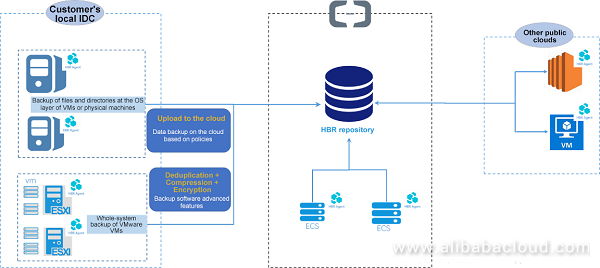
In this scenario, HBR has the following advantages:
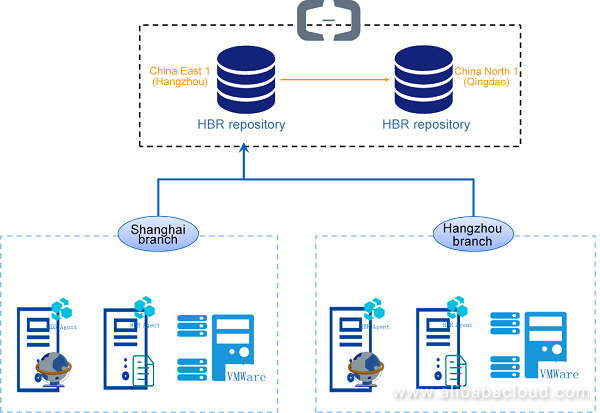
A customer has established multiple branches in different cities, provinces, and regions. Each branch has data to be backed up.
Backup devices need to be deployed in each physical IDC, resulting in scattered and complex management of devices. It is also difficult to ensure successful data backup.
Based on the multi-region disaster recovery requirements, the customer hopes that a copy of the backup data can be stored in another region to prevent data or services from becoming unavailable due to regional failures.
In this scenario, HBR has the following advantages:
Different from HBR, HDR provides "Cloud + Local" dual backup and cloud disaster recovery for enterprise applications. HDR protects servers, files, and applications. The disaster recovery server is deployed in the local IDC to quickly recover local data. At the same time, the backup data is synchronized to the cloud disaster recovery repository for disaster recovery on the cloud. If the IDC has a failure, HDR is able to recover the business server on the cloud to guarantee business continuity. HDR can also be used for disaster recovery drills or data analysis. To protect data in a big data cluster architecture, Alibaba Cloud has released the first big data backup and disaster recovery solution on the public cloud.
A customer needs to replicate the production environment in real time to ensure that the business can be quickly taken over on the cloud if a business failure occurs in the local IDC.
The business system is built based on a complete set of servers, including database servers, file servers, and application servers.
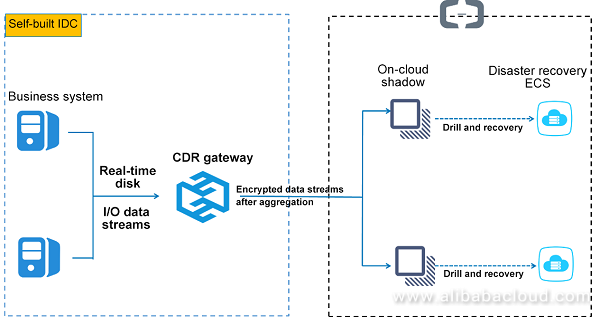
In this scenario, HDR has the following advantages:
A customer needs to replicate the production environment locally to ensure quick recovery of data in the local IDC if the data is deleted by mistake or a disk failure occurs.
The customer also requires remote disaster recovery for the local backup data to ensure that business can be quickly restored in the disaster recovery center if disasters occur in the local IDC, shortening the business interruption time.
The business system is built based on a complete set of servers, including database servers, file servers, and application servers.
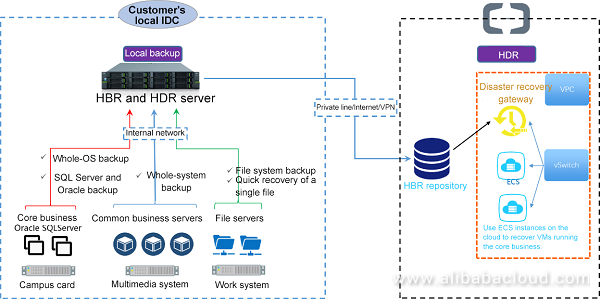
In this scenario, HDR has the following advantages:
A customer has deployed a Hadoop big data cluster, which contains hundreds of TB of data, in the local IDC. If a remote disaster recovery cluster of the same size is built, a lot of resources are idle and the costs are high.
The customer's required RPO is close to zero, which cannot be satisfied by the traditional DistCp solution.
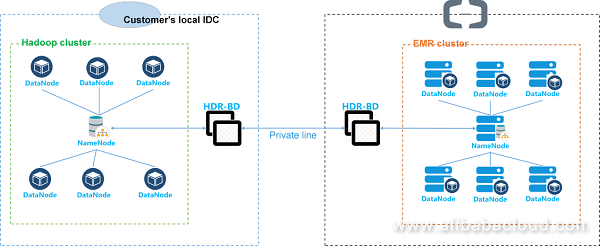
In this scenario, HDR has the following advantages:
HBR and HDR support multi-level RPO and RTO to meet different business disaster recovery requirements.
HBR and HDR ensure real-time replication of the core business, regular disaster recovery of key business, and regular backup of common business.
No hardware or gateway device is required.
The backup space is ready for use upon purchase and easy to expand.
The deduplication ratio of up to 30:1 allows 30 copies to occupy the original space of only one copy.
The permanent incremental technology prevents redundant data from being uploaded repeatedly and delivers an extremely fast speed for access to the cloud without private lines.
The amount of data is calculated and charged based on the cloud storage space instead of the source backup amount, minimizing backup costs.
The infrastructure of public cloud platforms reduces more than 70% of costs compared to the traditional disaster recovery center.
The data is backed up in multiple versions. A full copy is stored at each time point.
The cloud storage reliability is 99.9999999999%.
The multi-availability zone (AZ) backup repository for disaster recovery relies on the support of multiple zones on the cloud platform to protect data in multiple copies.
The configurable cross-region remote disaster recovery mode prevents data loss caused by major regional failures.
The whole system is backed up and recovered. Customers can recover the same business system on the cloud without the need to change applications or IP addresses.
When the whole system is on the cloud, the data of its offline IDC can reflow, which helps to restore applications to the original status after the offline IDC is recovered.
OS: Windows and Linux
System platform: VMware, Hyper-V, and physical servers
Database: SQL Server, Oracle, and other databases
Function Compute to Power Schedule Alibaba Cloud ECS Instances

2,598 posts | 769 followers
FollowAlibaba Clouder - September 4, 2020
Alibaba Clouder - September 19, 2018
Rizwan Khan - May 23, 2023
Alibaba Clouder - March 20, 2020
Mehmad - December 30, 2024
Alibaba Clouder - August 29, 2019

2,598 posts | 769 followers
Follow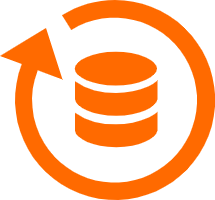 Database Backup
Database Backup
A reliable, cost-efficient backup service for continuous data protection.
Learn More Database for FinTech Solution
Database for FinTech Solution
Leverage cloud-native database solutions dedicated for FinTech.
Learn More Oracle Database Migration Solution
Oracle Database Migration Solution
Migrate your legacy Oracle databases to Alibaba Cloud to save on long-term costs and take advantage of improved scalability, reliability, robust security, high performance, and cloud-native features.
Learn More Database Migration Solution
Database Migration Solution
Migrating to fully managed cloud databases brings a host of benefits including scalability, reliability, and cost efficiency.
Learn MoreMore Posts by Alibaba Clouder
Start building with 50+ products and up to 12 months usage for Elastic Compute Service
Get Started for Free Get Started for Free